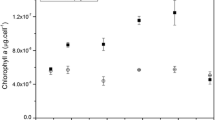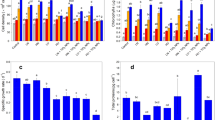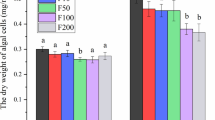Abstract
The impact of nanoparticles (NPs) in phytoplankton is understudied, particularly with respect to the organism’s physiology and environmentally relevant concentrations. In the present research, we investigated the effects of titanium dioxide nanoparticles (nano-TiO2) in the physiology of Scenedesmus bijugus, a freshwater cosmopolitan phytoplankter, exposed to concentrations ranging from 3.30 × 10−9 mol L−1 (log −8.48) to 3.70 × 10−7 mol L−1 (log −6.43), which includes environmentally relevant values. The nano-TiO2 concentrations in the medium and in the cells were determined in experiments that lasted 96 h. Controlled environmental conditions were used throughout and a variety of endpoints were monitored. These included cell density, cell viability, chlorophyll a concentration, growth rates, maximum quantum yield of photosystem II (ΦM), intracelular proteins and carbohydrates, and proteins:carbohydrates ratios. The results showed that cell viability was the most sensitive parameter for the detection of the nano-TiO2 effects, being followed by ΦM. At the concentration of 3.90 × 10−8 mol L−1 (log −7.40), there was an increase of nano-TiO2 injured cells, and at 3.70 × 10−7 mol L−1 (log −6.43) 24%, ΦM decrease in comparison with the controls was obtained. Different from several literature results, we showed that nano-TiO2 particles at environmentally relevant concentrations affected microalgae physiology, and this was dependent on the endpoint used to evaluate the effect.






Similar content being viewed by others
References
AFNOR (1980). Association Française Normalisation. Norme experimentale. T90-304. Essais deseaux Determination de I’inhibition de Scenesdesmus subspicatus par une substance, Paris, France (1980).
Agustí, S., & Sánchez, C. (2002). Cell viability in natural phytoplankton communities quantified by a membrane permeability probe. Limnology and Oceanography, 47, 818–828.
Aruoja, V., Dubourguier, H. C., Kasemets, K., & Kahru, A. (2009). Toxicity of nanoparticles of CuO, ZnO and TiO2 to microalgae Pseudokirchneriella subcapitata. Science of the Total Environment, 407, 1461–1468. doi:10.1016/j.scitotenv.2008.10.053.
Baker, T. J., Tyler, C. R., & Galloway, T. S. (2013). Impacts of metal and metal oxide nanoparticles on marine organisms. Environmental Pollution, 186, 257–71. doi:10.1016/j.envpol.2013.11.014.
Bottero, J. Y., Auffan, M., Borschnek, D., Chaurand, P., Labille, J., Levard, C., Masion, A., Tella, M., Rose, J., & Wiesner, M. R. (2015). Nanotechnology, global development in the frame of environmental risk forecasting. a necessity of interdisciplinary researches. Comptes Rendus Geoscience, 347, 35–42. doi:10.1016/j.crte.2014.10.004.
Bradford, M. (1976). A rapid and sensitive method for the quantization of microgram quantities of protein utilizing the principle of protein-dye binding. Analytical Biochemistry, 72, 243–254.
Brunauer, S., Emmet, P. H., & Teller, E. (1938). Absorption of gases in multimolecular layers. Journal of the American Chemical Society, 60, 309–319.
Cardinale, B. J., Bier, R., & Kwan, C. (2012). Effects of TiO2 nanoparticles on the growth and metabolism of three species of freshwater algae. Journal of Nanoparticle Research. doi:10.1007/s11051-012-0913-6.
Cherchi, C. (2012). Ecotoxicity and environmental implications of nano titanium dioxide revealed through primary producers surrogates—cyanobacteria. Civil Engineering Dissertations. Paper 16. Northeastern University, Department of Civil and Environmental Engineering (http://hdl.handle.net/2047/d20002839).
Dalai, S., Pakrashi, S., Nirmala, M. J., Chaudhri, A., Chandrasekaran, N., Mandal, A. B., & Mukherjee, A. (2013). Cytotoxicity of TiO2 nanoparticles and their detoxification in a freshwater system. Aquatic Toxicology, 138–139, 1–11. doi:10.1016/j.aquatox.2013.04.005.
Echeveste, P., Sánchez, A. T., & Agustí, S. (2014). Tolerance of polar phytoplankton communities to metals. Environmental Pollution, 185, 188–195. doi:10.1016/j.envpol.2013.10.029.
Ganf, G. G., Stone, S. J. L., & Oliver, R. L. (1986). Use of protein to carbohydrate ratios to analyse for nutrient deficiency in phytoplankton. Australian Journal Marine Freshwater Reserve, 37, 183–197. doi:10.1071/MF9860183.
Garrido, M., Cecchi, P., Vaquer, A., & Pasqualini, V. (2013). Effects of sample conservation on assessments of the photosynthetic efficiency of phytoplankton using PAM fluorometry. Deep Sea Research Pt. I, 71, 38–48. doi:10.1016/j.dsr.2012.09.004.
Gorelik, S., Rastorguev, L., & Skakov, Y.U. (1963). X-ray diffraction and electro-optic analysis of metals. Metallurgizdat 256.
Govorov, A. O., & Carmeli, I. (2007). Hybrid structures composed of photosynthetic system and metal nanoparticles: plasmon enhancement effect. Nanotechnology Letter, 7, 620–625. doi:10.1021/nl062528t.
Gubbins, E. J., Batty, L. C., & Lead, J. R. (2011). Phytotoxicity of silver nanoparticles to Lemna minor L. Environmental Pollution, 159(6), 1551–9. doi:10.1016/j.envpol.2011.03.002.
Hartmann, N. B., Kammer, F. V., Hofmann, T., Baalousha, M., Ottofuelling, S., & Baun, A. (2010). Algal testing of titanium dioxide nanoparticles-testing considerations, inhibitory effects and modification of cadmium bioavailability. Toxicology, 296, 190–197. doi:10.1016/j.tox.2009.08.008.
Hassellöv, M., Readman, J. W., Ranville, J. F., & Tiede, K. (2008). Nanoparticle analysis and characterization methodologies in environmental risk assessment of engineered nanoparticles. Ecotoxicology, 17, 344–361. doi:10.1007/s10646-008-0225-x.
He, D., Dorantes-Aranda, J. J., & Waite, T. D. (2012). Silver nanoparticle-algae interactions: oxidative dissolution, reactive oxygen species generation and synergistic toxic effects. Environmental Science & Technology, 46, 8731–8738. doi:10.1021/es300588a.
Joner, E.J., Hartnik, T., & Amundsen, C.E. (2008). Environmental fate and ecotoxicity of engineered nanoparticles. http://www.nanotechia.org/global-news/norwegian-authorities-assess-environmental-fate-an. Accessed 5 January 2016. ISBN 978-82-7655-540-0.
Juhel, G., Batisse, E., Hugues, Q., Daly, D., Van Pelt, F. N., O’halloran, J., & Jansen, M. A. (2011). Alumina nanoparticles enhance growth of Lemna minor. Aquatic Toxicology, 105(3-4), 328–36. doi:10.1016/j.aquatox.2011.06.019.
Juneau, P., Qiu, B., & Deblois, C. P. (2007). Use of chlorophyll fluorescence as a tool for determination of herbicide toxic effect: review. Environmental Toxicology & Chemistry, 89, 609–625. doi:10.1080/02772240701561569.
Kadar, E., Rooks, P., Lakey, C., & White, D. A. (2012). The effect of engineered nanoparticles on growth and metabolic status of marine microalgae cultures. Science of the Total Environment, 439, 8–17.
Kilham, S., Kreeger, D. A., Gouldern, C. E., & Lynn, S. G. (1997). Effects of nutrient limitation on biochemical constituents of Ankistrodesmus falcatus. Freshwater Biology, 38, 591–59. doi:10.1046/j.1365-2427.1997.00231.x.
Krajnik, B., Gajda-rączka, M., Piątkowski, D., Nyga, P., Jankiewicz, B., Hofmann, E., & Mackowski, S. (2013). Silica nanoparticles as a tool for fluorescence collection efficiency enhancement. Nanoscale Research Letters, 8, 146. doi:10.1186/1556-276X-8-146.
Kulacki, K. J., & Cardinale, B. J. (2012). Effects of nano-titanium dioxide on freshwater algal population dynamics. PLoS One, 7(10), e47130. doi:10.1371/journal.pone.0047130.
Kulacki, K. J., Cardinale, B. J., Keller, A. A., Bier, R., & Dickson, H. (2012). How do stream organisms respond to, and influence, the concentration of titanium dioxide nanoparticles? A mesocosm study with algae and herbivores. Environmental Toxicology & Chemistry, 31, 2414–2422. doi:10.1002/etc.1962.
Liu, D., Wong, P. T. S., & Dutka, B. J. (1973). Determination of carbohydrate in lake sediment by a modified phenol-sulfuric acid method. Water Research, 7, 741–46. doi:10.1016/0043-1354(73)90090-0.
Liu, Y., Wang, W., Zhang, M., **ng, P., & Yang, Z. (2010). PSII-efficiency, polysaccharide production, and phenotypic plasticity of Scenedesmus obliquus in response to changes in metabolic carbon flux. Biochemical System Ecology, 38, 292–299. doi:10.1016/j.bse.2010.02.003.
Lombardi, A. T., & Maldonado, M. T. (2011). The effects of copper on the photosynthetic response of Phaeocystis cordata. Photosynthesis Research, 108, 77–78. doi:10.1007/s11120-011-9655-z.
Lombardi, A. T., Vieira, A. A. H., & Sartori, L. A. (2002). Mucilacinous capsule adsorption and intracellular uptake of copper by Kirchneriella aperta (Chlorococcales). Journal of Phycology, 38, 332–337. doi:10.1046/j.1529-8817.2002.00126.x.
Melegari, S. P., Perreault, P., Costa, R. H. R., Popovic, R., & Matias, W. G. (2013). Evaluation of toxicity and oxidative stress induced by copper oxide nanoparticles in the green alga Chlamydomonas reinhardtii. Aquatic Toxicology, 142–143, 431–440. doi:10.1016/j.aquatox.2013.09.015.
Mueller, N. C., & Nowack, B. (2008). Exposure modeling of engineered nanoparticles in the environment. Environmental Science & Technology, 42, 4447–4453. doi:10.1021/es7029637.
Navarro, E., Piccapietra, F., Wagner, B., Marconi, F., Kaegi, R., Odzak, N., Sigg, L., & Behra, R. (2008a). Toxicity of silver nanoparticles to Chlamydomonas reinhardtii. Environmental Science & Technology, 42, 8959–8964. doi:10.1021/es801785m.
Navarro, E., Baun, A., Behra, R., Hartmann, N. B., Filser, J., Miao, A. J., Quigg, A., Santschi, P. H., & Sigg, L. (2008b). Environmental behavior and ecotoxicity of engineered nanoparticles to algae, plants, and fungi. Ecotoxicology, 17, 372–386. doi:10.1007/s10646-008-0214-0.
Perron, M.-C., Qiu, B., Boucher, N., Bellemare, F., & Juneau, P. (2012). Use of chlorophyll a fluorescence to detect the effect of microcystins on photosynthesis and photosystem II energy fluxes of green algae. Toxicon, 59, 567–577. doi:10.1016/j.toxicon.2011.12.005.
Rausch, T. (1981). The estimation of micro-algal protein content and its meaning to the evaluation of algal biomass I. comparison of methods for extracting protein. Hydrobiologia, 78, 237–251.
Ribeiro, F., Gallego-Urrea, J. A., Jurkschat, K., Crossley, A., Hassellöv, M., Taylor, C., Soares, A. M. V. M., & Loureiro, S. (2014). Silver nanoparticles and silver nitrate induce high toxicity to Pseudokirchneriella subcapitata, Daphnia magna and Danio rerio. Science of the Total Environment, 466–467, 232–241. doi:10.1016/j.scitotenv.2013.06.101.
Rocha, G. S., Pinto, F. H. V., Melao, M. G. G., & Lombardi, A. T. (2014). Growing Scenedesmus quadricauda in used culture media: is it viable? Journal of Applied Phycology. doi:10.1007/s10811-014-0320-8.
Sadiq, I. M., Swayamprava, D. N., & Chandrasekaran, A. M. (2011). Ecotoxicity study of titania (TiO2) NPs on two microalgae species: Scenedesmus sp. and Chlorella sp. Ecotox. Environmental Safety, 74, 1180–1187. doi:10.1016/j.ecoenv.2011.03.006.
Saison, C., Perreault, F., Daigle, J. C., Fortin, C., Claverie, J., Morin, M., & Popovic, R. (2010). Effect of core–shell copper oxide nanoparticles on cell culture morphology and photosynthesis (photosystem II energy distribution) in the green alga, Chlamydomonas reinhardtii. Aquatic Toxicology, 96, 109–114. doi:10.1016/j.aquatox.2009.10.002.
Shang, L., Nienhaus, K., & Nienhaus, G. U. (2014). Engineered nanoparticles interacting with cells: size matters. Journal of Nanbiotechnology, 12, 5–16. doi:10.1186/1477-3155-12-5.
Singsaas, E. L., Ort, D. R., & DeLucia, E. H. (2001). Variation in measured values of photosynthetic quantum yield in ecophysiological studies. Oecologia, 128, 15–23. doi:10.1007/s004420000624.
Tang, Y. Z., & Dobbs, F. C. (2007). Green autofluorescence in Dinoflagellates, Diatoms, and other microalgae and its implications for vital staining and morphological studies. Applied and Environmental Microbiology, 73, 2306–2313. doi:10.1128/AEM.01741-06.
Tang, Y., Li, S., Qiao, J., Wang, H., & Li, L. (2013). Synergistic effects of nano-sized titanium dioxide and zinc on the photosynthetic capacity and survival of Anabaena sp. International Journal of Molecular Sciences, 14, 14395–14407. doi:10.3390/ijms140714395.
Yeung, K. L., Leung, W. K., Yao, N., & Cao, S. (2009). Reactivity and antimicrobial properties of nanostructured titanium dioxide. Catalysis Today, 143, 218–224. doi:10.1016/j.cattod.2008.09.036.
Acknowledgments
We thank Prof. Dr. Edson Roberto Leite and collaborators for NP characterization, and Prof. Dr. Joaquim A. Nobrega and Dr. Clarisse D. B. Amaral for Ti determinations. ATL thanks Conselho Nacional de Desenvolvimento Científico e Tecnológico (CNPq—Brazil) (302175/2015-6) for financial support and Coordenação de Aperfeiçoamento de Pessoal de Nível Superior – Demanda Social (Capes-DM) for a scholarship.
Author information
Authors and Affiliations
Corresponding author
Rights and permissions
About this article
Cite this article
Barreto, D.M., Lombardi, A.T. Environmentally Relevant Concentrations of TiO2 Nanoparticles Affected Cell Viability and Photosynthetic Yield in the Chlorophyceae Scenedesmus bijugus . Water Air Soil Pollut 227, 450 (2016). https://doi.org/10.1007/s11270-016-3139-x
Received:
Accepted:
Published:
DOI: https://doi.org/10.1007/s11270-016-3139-x




